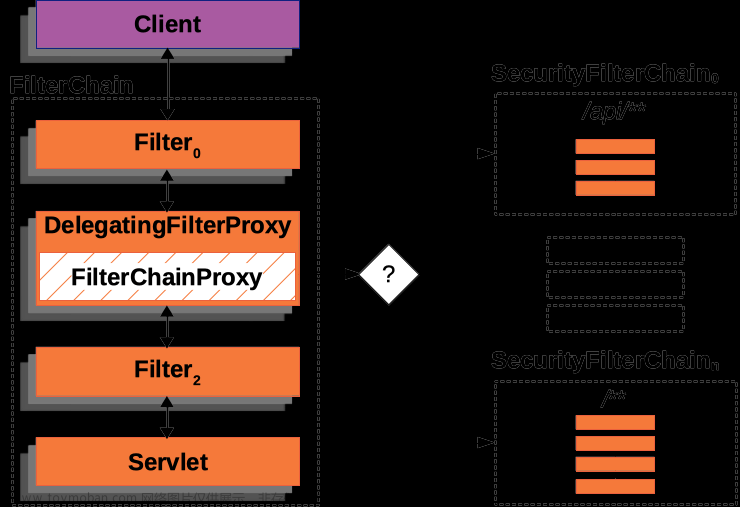一. 前言
学习了SpringSecurity的使用,以及跟着源码分析了一遍认证流程,掌握了这个登录认证流程,才能更方便我们做自定义操作。
下面我们来学习下怎么实现多种登录方式,比如新增加一种邮箱验证码登录的形式,但SpringSecurity默认的Usernamepassword方式不影响。
二. 自定义邮件验证码认证
0. 说明
自定义一个邮箱验证码的认证,将邮箱号码作为key,验证码作为value存放到Redis中缓存。
1. 回顾
首先回顾下之前源码分析的认证流程,如下图:

2. 设计思路
-
首先前端是填写邮箱,点击获取验证码
-
输入获取到的验证码,点击登录按钮,发送登录接口(/emial/login,此处不能使用默认的
/login,因为我们属于扩展) -
自定义过滤器
EmailCodeAuthenticationFilter(类似UsernamepasswordAuthenticationFilter),获取邮箱号码与验证码 -
将邮箱号码与验证码封装为一个需要认证的自定义
Authentication对象EmailCodeAuthenticationToken(类似UsernamepasswordAuthenticationToken) -
将
EmailCodeAuthenticationToken传给AuthenticationManager接口的authenticate方法认证 -
因为
AuthenticationManager的默认实现类为ProviderManager,而ProviderManager又是委托给了AuthenticationProvider,因此自定义一个
AuthenticationProvider接口的实现类EmailCodeAuthenticationProvider,实现authenticate方法认证 -
认证成功与认证失败的处理:一种是直接在过滤器
EmailCodeAuthenticationFilter中重写successfulAuthentication和unsuccessfulAuthentication,另一种是实现AuthenticationSuccessHandler和AuthenticationFailureHandler进行处理 -
总归一句:照猫画瓢
总结:
需要实现以下几个类:
- 过滤器EmailCodeAuthenticationFilter
- Authentication对象EmailCodeAuthenticationToken
- AuthenticationProvider类EmailCodeAuthenticationProvider
- 自定义认证成功与认证失败的Handler
3. 代码实现
-
自定义Authentication对象(这里是EmailCodeAuthenticationToken)
public class EmailCodeAuthenticationToken extends AbstractAuthenticationToken { private static final long serialVersionUID = SpringSecurityCoreVersion.SERIAL_VERSION_UID; // 邮箱账号 private final Object principal; // 邮箱验证码 private Object credentials; /** * 没有经过验证时,权限位空,setAuthenticated设置为不可信令牌 * @param principal * @param credentials */ public EmailCodeAuthenticationToken(Object principal, Object credentials) { super(null); this.principal = principal; this.credentials = credentials; setAuthenticated(false); } /** * 已认证后,将权限加上,setAuthenticated设置为可信令牌 * @param principal * @param credentials * @param authorities */ public EmailCodeAuthenticationToken(Object principal, Object credentials, Collection<? extends GrantedAuthority> authorities) { super(authorities); this.principal = principal; this.credentials = credentials; super.setAuthenticated(true); } @Override public Object getCredentials() { return this.credentials; } @Override public Object getPrincipal() { return this.principal; } @Override public void setAuthenticated(boolean isAuthenticated) throws IllegalArgumentException { Assert.isTrue(!isAuthenticated, "Cannot set this token to trusted - use constructor which takes a GrantedAuthority list instead"); super.setAuthenticated(false); } @Override public void eraseCredentials() { super.eraseCredentials(); this.credentials = null; } }说明:
模仿UsernamepasswordAuthenticationToken定义,继承AbstractAuthenticationToken,这里注意的是要定义两个构造器,分别对应未认证和已认证的Token,已认证的调用
super.setAuthenticated(true); -
自定义Filter(这里是EmailCodeAuthenticationFilter)
public class EmailCodeAuthenticationFilter extends AbstractAuthenticationProcessingFilter { // 前端传来的参数名 private final String SPRING_SECURITY_EMAIL_KEY = "email"; private final String SPRING_SECURITY_EMAIL_CODE_KEY = "email_code"; // 自定义的路径匹配器,拦截Url为:/email/login private static final AntPathRequestMatcher DEFAULT_ANT_PATH_REQUEST_MATCHER = new AntPathRequestMatcher("/email/login", "POST"); // 是否仅POST方式 private boolean postOnly = true; public EmailCodeAuthenticationFilter() { super(DEFAULT_ANT_PATH_REQUEST_MATCHER); } /** * 认证方法,在父类的doFilter中调用 * @param request * @param response * @return * @throws AuthenticationException * @throws IOException * @throws ServletException */ @Override public Authentication attemptAuthentication(HttpServletRequest request, HttpServletResponse response) throws AuthenticationException, IOException, ServletException { if (this.postOnly && !request.getMethod().equals("POST")) { throw new AuthenticationServiceException("Authentication method not support : " + request.getMethod()); } System.out.println("email attemptAuthentication"); // 获取邮箱号码 String email = obtainEmail(request); email = (email != null) ? email : ""; email = email.trim(); // 获取邮箱验证码 String emailCode = obtainEmailCode(request); emailCode = (emailCode != null) ? emailCode : ""; // 构造Token EmailCodeAuthenticationToken authRequest = new EmailCodeAuthenticationToken(email, emailCode); setDetails(request, authRequest); // 使用AuthenticationManager来进行认证 return this.getAuthenticationManager().authenticate(authRequest); } /** * 获取请求中email参数 * @param request * @return */ @Nullable protected String obtainEmail(HttpServletRequest request) { return request.getParameter(this.SPRING_SECURITY_EMAIL_KEY); } /** * 获取请求中验证码参数email_code * @param request * @return */ @Nullable protected String obtainEmailCode(HttpServletRequest request) { return request.getParameter(this.SPRING_SECURITY_EMAIL_CODE_KEY); } protected void setDetails(HttpServletRequest request, EmailCodeAuthenticationToken authRequest) { authRequest.setDetails(this.authenticationDetailsSource.buildDetails(request)); } }说明:
模仿UsernamepasswordAuthentionFilter实现自定义的过滤器,核心是attemptAuthentication方法.
-
自定义AuthenticationProvider(这里是EmailCodeAuthenticationProvider)
public class EmailCodeAuthenticationProvider implements AuthenticationProvider { protected MessageSourceAccessor messages = SpringSecurityMessageSource.getAccessor(); private EmailCodeUserDetailsService emailCodeUserDetailsService; @Override public Authentication authenticate(Authentication authentication) throws AuthenticationException { Assert.isInstanceOf(EmailCodeAuthenticationToken.class, authentication, () -> this.messages.getMessage("AbstractUserDetailsAuthenticationProvider.onlySupports", "Only UsernamePasswordAuthenticationToken is supported")); // 此时的authentication还没认证,获取邮箱号码 EmailCodeAuthenticationToken unAuthenticationToken = (EmailCodeAuthenticationToken) authentication; // 做校验 UserDetails user = this.emailCodeUserDetailsService.loadUserByEmail(unAuthenticationToken); if (user == null) { throw new InternalAuthenticationServiceException("EmailCodeUserDetailsService returned null, which is an interface contract violation"); } System.out.println("authentication successful!"); Object principalToReturn = user; return createSuccessAuthentication(principalToReturn, authentication, user); } @Override public boolean supports(Class<?> authentication) { return EmailCodeAuthenticationToken.class.isAssignableFrom(authentication); } protected Authentication createSuccessAuthentication(Object principal, Authentication authentication, UserDetails user) { EmailCodeAuthenticationToken result = new EmailCodeAuthenticationToken(principal, authentication.getCredentials(), user.getAuthorities()); result.setDetails(authentication.getDetails()); return result; } public void setEmailCodeUserDetailsService(EmailCodeUserDetailsService emailCodeUserDetailsService) { this.emailCodeUserDetailsService = emailCodeUserDetailsService; } }说明:
Provider是真正做认证的地方,这里调用emailCodeUserDetailsService服务去执行验证,因为要用到这个Service,所以提供了一个set方法setEmailCodeUserDetailsService用于注入。这里的这个service是我们自定义的,可以不用实现UserDetailsService, Service里的逻辑可以自定义
-
自定义认证成功与失败的Handler
public class EmailCodeAuthenticationSuccessHandler implements AuthenticationSuccessHandler { @Override public void onAuthenticationSuccess(HttpServletRequest request, HttpServletResponse response, Authentication authentication) throws IOException, ServletException { response.setContentType("text/plain;charset=UTF-8"); response.getWriter().write(authentication.getName()); } } public class EmailCodeAuthenticationFailureHandler implements AuthenticationFailureHandler { @Override public void onAuthenticationFailure(HttpServletRequest request, HttpServletResponse response, AuthenticationException exception) throws IOException, ServletException { response.setContentType("text/plain;charset=UTF-8"); response.getWriter().write("邮箱验证码错误!"); } }说明:
这里的是认证成功或失败后的处理,需要实现对应的接口以及方法。这里的逻辑只是简单测试,具体逻辑以后根据业务逻辑去编写。
-
添加自定义认证的配置
为了让我们自定义的认证生效,需要将我们的Filter和Provider加入到SpringSecurity的配置中。这里我们使用
apply这个方法将其他一些配置合并到SpringSecurity的配置中,形成插件化。比如:httpSecurity.apply(new xxxxConfig()); 因此我们可以将我们的配置单独放到一个配置类中。
public class EmailCodeAuthenticationSecurityConfig extends SecurityConfigurerAdapter<DefaultSecurityFilterChain, HttpSecurity> { // 注入email验证服务 @Autowired private EmailCodeUserDetailsService emailCodeUserDetailsService; @Override public void configure(HttpSecurity http) { // 配置Filter EmailCodeAuthenticationFilter emailCodeAuthenticationFilter = new EmailCodeAuthenticationFilter(); // 设置AuthenticationManager emailCodeAuthenticationFilter.setAuthenticationManager(http.getSharedObject(AuthenticationManager.class)); // 设置认证成功处理Handler emailCodeAuthenticationFilter.setAuthenticationSuccessHandler(new EmailCodeAuthenticationSuccessHandler()); // 设置认证失败处理Handler emailCodeAuthenticationFilter.setAuthenticationFailureHandler(new EmailCodeAuthenticationFailureHandler()); // 配置Provider EmailCodeAuthenticationProvider emailCodeAuthenticationProvider = new EmailCodeAuthenticationProvider(); // 设置email验证服务 emailCodeAuthenticationProvider.setEmailCodeUserDetailsService(emailCodeUserDetailsService); // 将过滤器添加到过滤器链路中 http.authenticationProvider(emailCodeAuthenticationProvider).addFilterAfter(emailCodeAuthenticationFilter, UsernamePasswordAuthenticationFilter.class); } }注意:
这里需要注意的是,一定要将
AuthenticationManager提供给Filter,如果没有这一步,那么在Filter中进行认证的时候无法找到对应的Provider,因为AuthenticationManger就是管理Provider的。
http.getSharedObject(AuthenticationManager.class)解释:
SharedObject是在配置中进行共享的一些对象,HttpSecurity共享了一些非常有用的对象可以供外部使用,比如AuthenticationManager最后在SpringSecurity的主配置中加入我们的自定义配置:
@Configuration public class MySecurityConfig extends WebSecurityConfigurerAdapter { @Autowired private EmailCodeAuthenticationSecurityConfig emailCodeAuthenticationSecurityConfig; @Autowired private DefaultUserDetailsService defaultUserDetailsService; @Bean public PasswordEncoder passwordEncoder() { return new BCryptPasswordEncoder(); } @Bean @Override protected AuthenticationManager authenticationManager() throws Exception { return super.authenticationManager(); } @Override protected void configure(AuthenticationManagerBuilder auth) throws Exception { auth.userDetailsService(defaultUserDetailsService); } @Override public void configure(WebSecurity web) throws Exception { web.ignoring().antMatchers("/getEmailCode", "/**/*.html"); } @Override protected void configure(HttpSecurity http) throws Exception { http.authorizeRequests() .anyRequest() .authenticated() .and() .formLogin() .loginPage("/login.html") .loginProcessingUrl("/login") .permitAll() .and() .logout() .logoutUrl("/logout") .and() .apply(emailCodeAuthenticationSecurityConfig) .and() .csrf() .disable(); } }说明:
因为这里使用了数据库保存用户信息,所以在SpringSecurity的默认表单登录里,修改了UserDetailService,在这里进行校验,所以在主配置中要设置UserDetailService:
auth.userDetailsService(defaultUserDetailsService); -
其他一些文件
查看我上传的gitee源码吧,整个工程都上传了。
-
前端页面实现
<!DOCTYPE html> <html lang="en"> <head> <meta charset="UTF-8"> <meta http-equiv="X-UA-Compatible" content="IE=edge"> <meta name="viewport" content="width=device-width, initial-scale=1.0"> <title>登录</title> <!-- 最新版本的 Bootstrap 核心 CSS 文件 --> <link rel="stylesheet" href="https://stackpath.bootstrapcdn.com/bootstrap/3.4.1/css/bootstrap.min.css" integrity="sha384-HSMxcRTRxnN+Bdg0JdbxYKrThecOKuH5zCYotlSAcp1+c8xmyTe9GYg1l9a69psu" crossorigin="anonymous"> <script src="http://libs.baidu.com/jquery/2.1.4/jquery.min.js"></script> <!-- 最新的 Bootstrap 核心 JavaScript 文件 --> <script src="https://stackpath.bootstrapcdn.com/bootstrap/3.4.1/js/bootstrap.min.js" integrity="sha384-aJ21OjlMXNL5UyIl/XNwTMqvzeRMZH2w8c5cRVpzpU8Y5bApTppSuUkhZXN0VxHd" crossorigin="anonymous"></script> <style> body { background-color: gray; } .login-div { width: 400px; /* height: 200px; */ margin: 0 auto; margin-top: 200px; border: 1px solid black; padding: 10px; } </style> </head> <body> <div class="login-div"> <ul class="nav nav-tabs" role="tablist"> <li class="active"> <a href="#usernameLogin" data-toggle="tab">用户名登录</a> </li> <li> <a href="#emailLogin" data-toggle="tab">邮箱验证码登录</a> </li> </ul> <!-- 用户名登录 --> <div class="tab-content"> <div class="tab-pane active" id="usernameLogin"> <form action="/login" method="POST"> <div class="form-group"> <label>用户名</label> <input type="text" class="form-control" placeholder="Username" name="username"> </div> <div class="form-group"> <label>密码</label> <input type="password" class="form-control" placeholder="Password" name="password"> </div> <div class="checkbox"> <label> <input type="checkbox" name="rememberType"> 记住我 </label> </div> <button type="submit" class="btn btn-default">登录</button> </form> </div> <!-- 邮箱登录 --> <div class="tab-pane" id="emailLogin"> <form action="/email/login" method="POST"> <div class="form-group" > <label>邮箱地址</label> <input type="email" class="form-control" placeholder="Email" name="email" id="email"> </div> <div class="form-group"> <label>验证码</label> <input type="text" class="form-control" placeholder="Code" name="email_code"> </div> <div class="form-group"> <label> <button type="button" class="btn btn-default" id="getCode">获取验证码</button> <span id="showCode" style="margin-left: 20px;"></span> </label> </div> <button type="submit" class="btn btn-default">登录</button> </form> </div> </div> </div> <script> $('#nav a').on('click', function(e) { e.preventDefault(); $(this).tab('show'); }); $('#getCode').on('click', function() { $.ajax({ type: "GET", url: "/getEmailCode", data: { email: $('#email').val() }, // dataType: "dataType", success: function (response) { $('#showCode').text(response); } }); }); </script> </body> </html>说明:
前端页面只是简单的显示使用两种方式来登录的操作,一些输入校验什么的没有详细实现,所以这里默认各位大佬都是正常操作哈。
这个前端支持两种登录方式,用户名密码登录方式使用的SpringSecurity默认的UsernamepasswordAuthenticationFilter,邮箱验证码使用的是自定义的EmailCodeAuthenticationFilter,在邮箱登录页面,点击获取验证码按钮,会请求服务器获取一个随机的字符串作为验证码,并且存入Redis中,有效期60s(记住我功能在这里没有实现)


-
数据库操作
因为目前只是自定义认证,不涉及授权,所以只有一个用户表文章来源:https://www.toymoban.com/news/detail-470240.html
CREATE TABLE `user` ( `id` INT(11) NOT NULL AUTO_INCREMENT, `username` VARCHAR(32) DEFAULT NULL, `password` VARCHAR(255) DEFAULT NULL, `email` VARCHAR(255) DEFAULT NULL, `enabled` TINYINT(1) DEFAULT NULL, PRIMARY KEY (`id`) ) ENGINE=INNODB AUTO_INCREMENT=0 DEFAULT CHARSET=utf8; INSERT INTO `user` VALUES ('1', 'root', '$2a$10$RMuFXGQ5AtH4wOvkUqyvuecpqUSeoxZYqilXzbz50dceRsga.WYiq','123456@qq.com', '1');随便插入一个用户,密码是123,数据库的是经过加密的。文章来源地址https://www.toymoban.com/news/detail-470240.html
到了这里,关于SpringSecurity自定义认证的文章就介绍完了。如果您还想了解更多内容,请在右上角搜索TOY模板网以前的文章或继续浏览下面的相关文章,希望大家以后多多支持TOY模板网!












